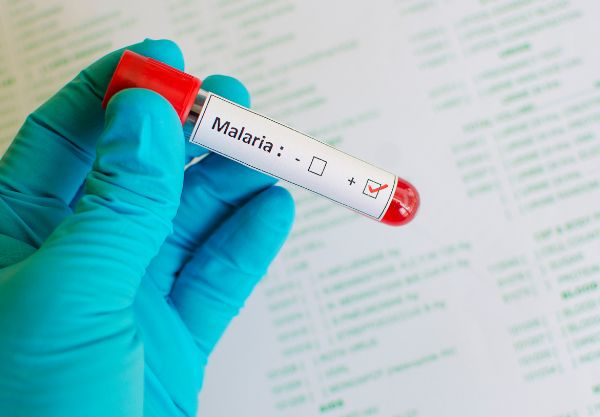Table of Contents
Objective:
This article explains the scientific reasoning behind the use of colloidal gold conjugates in malaria rapid diagnostic test kits. It focuses on the functional mechanism, diagnostic impact and design compatibility of colloidal gold in test devices such as the malaria rapid screen test, malaria antigen test kit and malaria home test kit, while maintaining clarity for healthcare professionals, technical personnel and informed readers.
How Does Colloidal Gold Function Within Malaria Rapid Diagnostic Test Kits?
In a malaria rapid diagnostic test kit, colloidal gold serves as a visible label. It is conjugated to monoclonal antibodies that specifically target malaria antigens such as HRP-2 (specific to P. falciparum) and pLDH (common to multiple malaria species). These antibodies are immobilized on the test strip’s membrane.
When a patient’s blood sample is introduced, it lyses and releases any potential antigens. If antigens are present, they bind to the colloidal gold-conjugated antibodies. This antigen-antibody complex continues to migrate through the strip until it reaches a zone pre-coated with another antibody – this time fixed – to capture the complex.
The accumulation of gold particles in this zone causes a visible purple line to appear, signaling a positive test. The absence of a line indicates a negative result. A separate control line ensures that the test has been performed correctly.
Because colloidal gold particles are inherently red to purple in color, they are highly visible without the need for additional detection instruments, making them ideal for point-of-care settings and malaria home test kits.
Why Is Colloidal Gold Preferred Over Other Detection Labels?
Several features make colloidal gold particularly suited for use in malaria rapid test kits:
- Stability: Colloidal gold conjugates remain stable under varied temperature and humidity conditions, making them reliable in tropical regions where malaria is endemic.
- Size and Optical Properties: Gold nanoparticles exhibit surface plasmon resonance, producing an intense color that is easily visible to the naked eye even at low concentrations.
- Ease of Conjugation: Proteins, especially antibodies, can adsorb onto gold surfaces efficiently without denaturing, allowing strong and specific binding to target antigens.
- Non-Enzymatic Nature: Unlike enzyme-based detection systems, gold particles do not require substrates or additional reagents, reducing test complexity.
Because of these traits, gold conjugates are integral to malaria antigen test kits and support the practical utility of malaria self-test kits in remote or resource-limited environments.
Colloidal gold conjugated antibodies are designed to bind these specific antigens, resulting in high test specificity and sensitivity. These interactions are central to the functionality of both hospital-grade malaria rapid diagnostic kits and malaria test kits for self-use.
What Type of Malaria Antigens Are Detected Using Colloidal Gold Conjugates?
The iCARE Malaria P.f/Pan Rapid Screen Test, as an example, targets two major antigen types:
- HRP-2 (Histidine-Rich Protein 2) – Specific to Plasmodium falciparum. This protein remains in the bloodstream even after the parasite is cleared, offering a diagnostic window for detecting recent infections.
- pLDH (Plasmodium Lactate Dehydrogenase) – Present in all malaria species (P. falciparum, P. vivax, P. ovale and P. malariae). This antigen indicates active infection and clears rapidly after treatment, making it useful for monitoring therapeutic success.

Colloidal gold conjugated antibodies are designed to bind these specific antigens, resulting in high test specificity and sensitivity. These interactions are central to the functionality of both hospital-grade malaria rapid diagnostic kits and malaria test kits for self-use.
Malaria Rapid Screen Tests: Why Colloidal Gold Enhance Accuracy?
Yes, colloidal gold may enhance the diagnostic accuracy of malaria rapid screen tests through the following mechanisms:
- Signal Clarity: Gold particles provide sharp visual contrast, reducing ambiguity in line visibility and improving interpretation.
- Reduced False Negatives: Because of their high affinity and specificity when conjugated properly, gold-labelled antibodies can bind to very low levels of malaria antigens, minimizing false negatives.
- Fast Results: Colloidal gold allows detection within 10–20 minutes, depending on the kit design. This rapid turnaround is vital for field applications and emergency settings.
The iCARE malaria test kit, for instance, shows results within 15 minutes and uses gold-labeled antibodies for both P. falciparum and non-falciparum species, delivering strong performance in various diagnostic scenarios.
How Colloidal Gold Conjugates Affect Test Sensitivity or Specificity?

Yes, the performance of colloidal gold conjugates can directly impact the sensitivity and specificity of a malaria rapid diagnostic kit. The sensitivity of a test refers to its ability to detect true positive cases, while specificity relates to the ability to exclude false positives.
For example, the iCARE Malaria P.f/Pan Rapid Screen Test can report a sensitivity of 96.9% and specificity of 99.7%. These performance levels are attributed in part to the high-quality monoclonal antibodies used and their effective conjugation with colloidal gold nanoparticles.
Incorrect preparation of colloidal gold conjugates or deterioration over time may reduce test reliability. Therefore, maintaining consistency in nanoparticle size, antibody quality and conjugation protocols is essential in malaria test kit manufacturing.
What Is the Role of Colloidal Gold in the Design of Home and Self-Test Kits?
In malaria self-test kits, simplicity and clarity are crucial. Colloidal gold conjugates serve this purpose effectively by eliminating the need for readers, reagents or technical expertise.
Key design advantages include:
- One-step operation: Users apply a blood sample and buffer directly, with visible results appearing without intervention.
- No instrument dependency: Unlike fluorescence or chemiluminescence-based systems, gold conjugates are visible without devices.
- Compact format: The compact size of the test cassette makes it feasible for personal use and storage.
These characteristics align with the goals of malaria self test kits, allowing individuals to conduct preliminary screening, especially in remote areas or during travel.

How Colloidal Gold Be Used with All Types of Malaria Test Formats?
Colloidal gold is compatible with various test formats, including:
- Cassette-based formats used in clinical and field settings.
- Dipstick designs employed in some low-resource environments.
- Integrated kits that include lancets, droppers, alcohol swabs and buffer – designed for single-use, portable applications.
Manufacturers may adapt the format based on the intended use-case, whether it is for clinics, outreach missions or direct-to-consumer applications. Regardless of design, colloidal gold remains a central element of the detection mechanism.
Conclusion
Colloidal gold conjugates play a pivotal role in the success of malaria rapid test kits by offering a reliable, visually discernible and chemically stable labeling method. These nanoparticles form the backbone of modern immunochromatographic assays, enabling accurate and timely detection of malaria antigens such as HRP-2 and pLDH.
Whether in clinical use, public health campaigns or malaria home test kits, the integration of colloidal gold enhances diagnostic effectiveness while keeping the test format user-friendly. Understanding its application helps medical professionals and test kit developers maintain high performance and consistency in the battle against malaria.
FAQs About Malaria Rapid Test Kits
What is colloidal gold and why is it used in malaria test kits?
Colloidal gold consists of tiny gold particles that bind to antibodies. It is used in malaria test kits because it creates a visible line when antigens are detected.
Can colloidal gold affect the accuracy of malaria rapid tests?
Yes, the quality and stability of colloidal gold conjugates can influence the test’s sensitivity and specificity.
Is colloidal gold safe to use in malaria home test kits?
Yes, colloidal gold is non-toxic and safe for diagnostic use in home testing kits.
Why does the test line appear purple or red?
The visible color results from the optical properties of gold nanoparticles, which reflect light in that spectrum.
Are there other types of labels used in malaria rapid diagnostic kits?
While colloidal gold is most common, some tests may use latex particles or fluorescent labels, though they may require special equipment.







